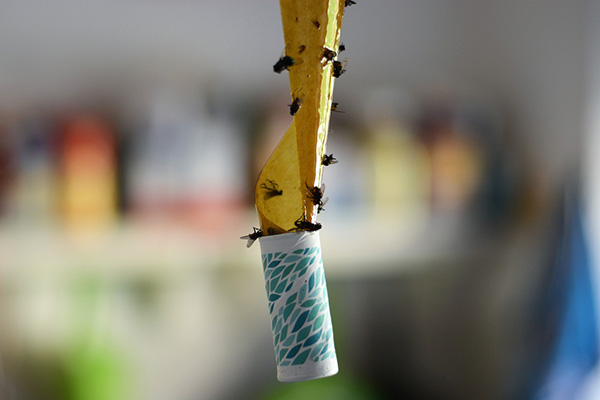Are you exhausted from battling those small, unwelcome visitors in your kitchen? We understand your frustration! Fruit flies seem to materialize unexpectedly, transforming your serene home into their lively playground. However, don't worry; we have exclusive tips on efficiently bidding farewell to these bothersome intruders. From homemade fruit fly traps to clever hacks, our guide is brimming with easy, effective methods to reclaim your kitchen. Say goodbye to fruit fly frustration and hello to a serene, fly-free home.
What Are Fruit Flies?
Fruit flies are small, ubiquitous insects, scientifically known as Drosophila melanogaster, often found in homes, grocery stores, and anywhere where food is processed. They are about 3 to 4 mm long and are easily identified by their red eyes and tan bodies.
Fruit flies are particularly attracted to ripened fruits and vegetables and are notorious for their rapid reproduction and ability to thrive in moist environments where organic material is present. While they are harmless to humans in terms of health, their presence can be a nuisance and indicative of overripe or decaying produce, which they use for feeding and breeding.
How do you distinguish fruit flies from fungus gnats or other bugs?
Though similar in size, fruit flies and fungus gnats have distinct differences. Fruit flies, often possessing a tan hue and red eyes, are drawn to ripe or fermenting fruits and vegetables. They're often found buzzing around kitchen areas where fresh produce is present.
In contrast, gnats, which can be black or dark brown, are more attracted to moist soil or organic decay and are common near houseplants or overwatered gardens.
The key to distinguishing them lies in their behavior and preferred habitats. Observing where these tiny insects congregate can indicate whether they are fruit flies attracted to your fruit bowl or gnats hovering around your plants.

How To Get Rid Of Fruit Flies
1. Clean and Clear
The first and most important step in eliminating fruit flies is to clean and clear. Creating a fruit fly-free environment starts with impeccable cleanliness. Make it a habit to wipe down all kitchen surfaces diligently, as even the smallest crumbs or spills can attract fruit flies.
Don't leave dirty dishes in the sink; wash them immediately after use. Fruit flies are drawn to food residues, so a clean sink is crucial. Additionally, clean under and around your kitchen appliances regularly. Food particles often accumulate in these hidden areas, turning them into fruit fly breeding hotspots.
2. Fruit Management
Proper fruit management plays a crucial role in warding off fruit fly infestations. It's important to store ripe fruits in the refrigerator, thereby making them less appealing and accessible to fruit flies. Regular inspections of fruit left at room temperature are essential. Overripe fruit and fruit juice are the main attractants for these pests, and they typically lay their eggs on rotting fruits and vegetables.
By diligently removing or chilling ripe fruits, you substantially decrease the chances of fruit flies becoming unwelcome guests in your kitchen and lessening the chance for female fruit flies to lay fruit fly eggs. This proactive approach is key to keeping these tiny nuisances at bay.
3. Seal the Deal
Fruit flies have the ability to infiltrate your living space through even the tiniest openings, underscoring the importance of securing potential entry points. Take the time to inspect and mend any gaps or tears in the seals around windows and doors.
Installing fine mesh screens on windows, especially in the kitchen area, can prevent fruit flies from entering your home while allowing fresh air to circulate.
4. Trash Talk
Your trash bin is a treasure chest for fruit flies if not appropriately managed. Ensure you empty your kitchen garbage bins regularly, ideally daily, if they contain food scraps.
Invest in bins with tightly fitting lids to prevent fruit flies from accessing the trash, thereby cutting off a significant food source and potential breeding ground.
5. Drain Drama
Sink drains serve as significant breeding grounds for fruit flies. Ensure their cleanliness and obstruction-free state by combining baking soda and vinegar. This natural cleaning solution helps to break down organic matter where fruit flies may breed. Follow this by flushing the drains with boiling water, which helps to remove any remaining debris and disrupt the breeding cycle of the fruit flies.

6. Trap Tactics
You must set up traps if you want to get rid of fruit flies fast. While you can purchase fruit fly traps, you can also make your own traps using the resources you have in your home. DIY traps can be highly effective in controlling fruit fly populations. And it can be as effective to kill fruit flies as chemical control tactics.
Several trap strategies can be employed using common kitchen materials you may already have. Each of these traps offers unique benefits, and choosing the right one can depend on your specific situation, the severity of the fruit fly problem, and the available materials.
Vinegar Trap
The vinegar trap is a highly effective fruit fly trap due to the strong attraction fruit flies have to the scent of vinegar, particularly apple cider vinegar. It is the most popular DIY fruit fly trap among homeowners.
To assemble this trap, fill a bowl or jar with apple cider vinegar, cover it with plastic wrap, and create small holes in the wrap. Fruit flies are attracted to the vinegar and enter through the holes but cannot escape. This method is notably advantageous due to its simplicity and the utilization of readily available household items. Adding a drop of dish soap alters the surface tension, causing the flies to drown and enhancing the trap's effectiveness.
Wine Trap
A wine trap leverages the fruit flies' attraction to the fermented scent of wine. Employ an empty wine bottle with a small amount of residual wine at the bottom. The bottle's narrow neck acts as a natural funnel, making it difficult for the flies to escape once they enter. Red wine, with its robust aroma, tends to be more effective. This method is advantageous because it repurposes leftover wine and is aesthetically discreet, blending into a home setting more naturally.
Fruit Trap
This method utilizes overripe or rotting fruit as bait. Put the fruit inside a jar and secure it with plastic wrap, creating holes in the wrap. Fruit flies, attracted to the decaying fruit, enter the trap but struggle to leave. The main advantage of the fruit trap is its use of natural bait, which is highly attractive to fruit flies. It's an excellent way to use up fruit that is past its prime while simultaneously tackling the fruit fly issue.
Yeast Trap
Yeast traps attract fruit flies through the smell of fermentation. Combine yeast with sugar and water in a container, cover it with plastic wrap, and make small holes in the wrap. The fermentation smell of yeast mimics the natural environments where fruit flies thrive, making this trap particularly effective. It's a great option for those who might not have vinegar or wine at hand and is a cost-effective solution.
Sticky Trap
Commercially available sticky traps use a glue-like surface to catch fruit flies. These can be placed or hung near fruit fly infestation areas. The main advantage of sticky traps is their convenience and ease of use. They require minimal setup and effectively capture fruit flies that land on them. This represents an effective passive trapping approach that can be positioned in diverse locations.
Electric Trap
Electric traps attract fruit flies using light and then trap or electrocute them. These traps are well-suited for dealing with significant infestations, providing a more hands-off approach. The advantage of electric traps is their efficiency and ease of maintenance. They can continuously trap fruit flies without needing bait replacement, making them suitable for long-term use in places with consistent fruit fly problems.
7. Essential Oils
Using essential oils like peppermint, eucalyptus, or lemongrass is a natural way to repel fruit flies. These scents are unattractive to them. Use these oils in a diffuser or mix a few drops with water to create a spray. Regularly misting areas prone to fruit fly activity can help keep them at bay.
8. Plant Power
Incorporating plants like basil and lavender into your kitchen decor is aesthetically pleasing and a natural deterrent for fruit flies. These plants emit scents that fruit flies find repulsive, thus helping to keep your kitchen free from these pests.
9. Professional Help
If you've exhausted various methods without successfully tackling fruit flies, seeking assistance from professional pest control services may be prudent. Experts can offer more potent solutions and identify breeding grounds that might not be obvious to the untrained eye. Their intervention can ensure a thorough eradication of fruit flies from your home.
